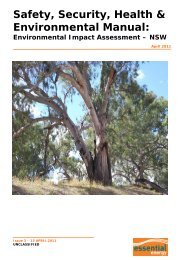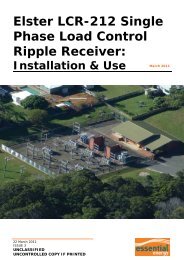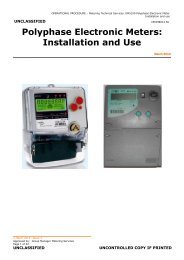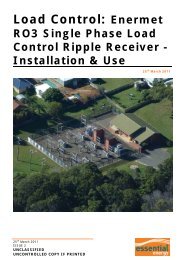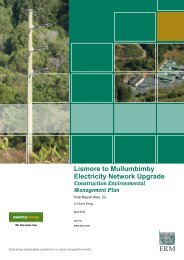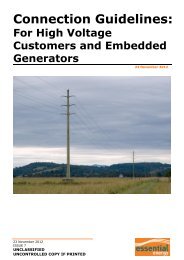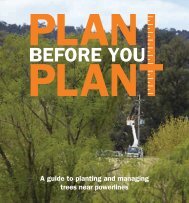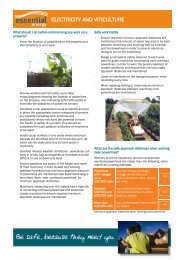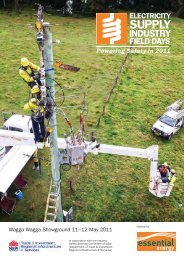Full Version - Essential Energy
Full Version - Essential Energy
Full Version - Essential Energy
Create successful ePaper yourself
Turn your PDF publications into a flip-book with our unique Google optimized e-Paper software.
• Large snowfalls in the Snowy Mountains, where field<br />
crews had to shovel through snow to access Perisher<br />
zone substation<br />
• Bushfires in Parkes – destroying up to 8,000 hectares<br />
of land and causing significant network damage.<br />
Twenty six poles had to be replaced over two days<br />
• Twenty-eight thousand lighting strikes in one night in<br />
Orange – extra crews from across the region called in<br />
to repair the damage.<br />
Our decentralised workforce allows the rapid<br />
deployment of employees and resources in<br />
emergencies. For instance, in October 2004 field<br />
crews from Grafton, Lismore, Ballina, Taree, Bathurst,<br />
Orange, Parkes and Forbes joined local crews in Coffs<br />
Harbour to quickly restore power to more than 15,000<br />
customers following severe storms and flooding.<br />
Independent review<br />
In October 2004, Country <strong>Energy</strong> invited a Price<br />
Waterhouse Coopers’ partner and consulting electrical<br />
engineer to undertake a high level independent<br />
assessment of our network asset management<br />
strategy. Conducted over three months, it relied<br />
on a mix of internal data, published information and<br />
interviews with managers and frontline employees.<br />
In February, the review authors reported that –<br />
Our overall assessment is that Country <strong>Energy</strong><br />
is heading in the right direction. By and large the<br />
appropriate systems and procedures are either in<br />
place, in the process of being put in place, or there<br />
are plans to put them in place at some stage in the<br />
next one to two years. Clearly, there is a great deal<br />
of work yet to be done, but we gained confidence<br />
that Country <strong>Energy</strong> has assessed the position well,<br />
knows what needs to be done and has plans in<br />
place to achieve its aims (page 8).<br />
The authors recognised benefits in our decentralised,<br />
regional management structure, reporting that –<br />
This allows local problems to be focused upon<br />
by management who are close to, and should<br />
understand local issues… While other models are<br />
worthy of consideration we believe that the structure<br />
currently in place has served Country <strong>Energy</strong> well<br />
(page 65).<br />
While we were reassured by the review’s findings,<br />
there is still much work to be done. We recognise there<br />
are further process improvements that we must make.<br />
Future goals – implement review recommendations<br />
to achieve industry leadership in network asset<br />
management.<br />
Better asset management<br />
Our asset management strategies and policies are<br />
well established, covering network planning and<br />
development, project design and management, risk<br />
management, reliability management, engineering<br />
standards, safety, network operations and maintenance.<br />
Our commitment to best practice asset management<br />
strategies is reflected in our Network Asset<br />
Management Plan, which employs the New South<br />
Wales Government’s Total Asset Management System.<br />
This plan details strategies to manage the entire<br />
network and invest in capacity and reliability-driven<br />
augmentation, asset maintenance, refurbishment and<br />
demand side management. The plan applies these<br />
strategies over the life of an asset, from construction<br />
to replacement or disposal and has three major<br />
elements – capital investment strategic planning, asset<br />
renewal and replacement strategic planning and asset<br />
maintenance strategic planning.<br />
AMOSS<br />
During the year, our Asset Management and Operating<br />
Support System (AMOSS) was extended to include<br />
details of all zone substation protection equipment.<br />
A project is also underway to load and manage zone<br />
substation maintenance.<br />
The system is accessed by a wide cross section of<br />
the business, with 1,200 registered users. Since<br />
its deployment last year, it has proved useful as<br />
a consolidated asset management system for all<br />
electricity network assets. The AMOSS applications<br />
provide automated transfer of asset data and a fieldbased<br />
mapping application for more than 100 asset<br />
inspectors and provides the mechanism for a further<br />
100 design project managers to create and manage<br />
network extension and system augmentation projects.<br />
Production of geographic map books for field staff is<br />
currently underway, with many field service centres<br />
already realising the benefits of a consolidated data<br />
source and application functionality designed to<br />
increase field operations productivity.<br />
Future goals – complete the geographic map books<br />
for field crews, expand system to accommodate<br />
gas network assets and the management of zone<br />
substation maintenance.<br />
21<br />
COUNTRY ENERGY ANNUAL REPORT 2004–2005




